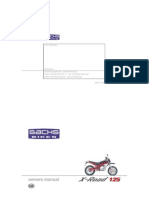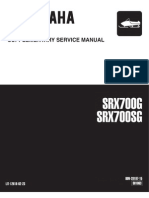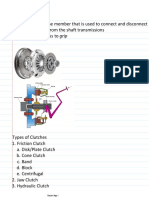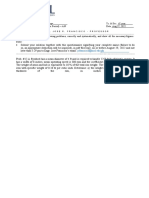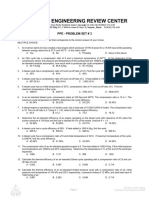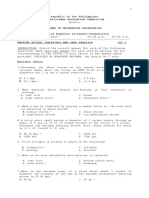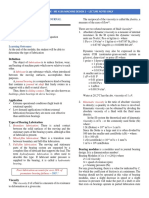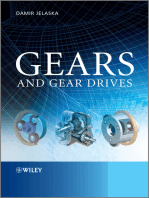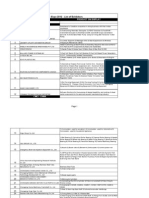Chain Drive Problems 2 PDF
Chain Drive Problems 2 PDF
Uploaded by
Hannah Phamela de GuzmanCopyright:
Available Formats
Chain Drive Problems 2 PDF
Chain Drive Problems 2 PDF
Uploaded by
Hannah Phamela de GuzmanOriginal Title
Copyright
Available Formats
Share this document
Did you find this document useful?
Is this content inappropriate?
Copyright:
Available Formats
Chain Drive Problems 2 PDF
Chain Drive Problems 2 PDF
Uploaded by
Hannah Phamela de GuzmanCopyright:
Available Formats
FME 212: Chain Drive Problems
1. Name five advantages of chain drives as compared to belt drives. A four-strand 12.7 mm pitch roller chain transmits 20 kW from a 21-tooth driving sprocket, which turns at 1200 rpm. The velocity ratio, defined as the ratio of the speed of the input shaft to that of he output shaft, is 0.25. Determine the tension in the chain. What should be the length of the chain if the centre distance is to be approximately 500 mm. 2. In a roller chain drive, discuss the effect of chain pitch on the impact between chain rollers and the sprockets. Discuss too, the effect of the number of teeth on the smaller sprocket, on the range of variation in chain speed due to chordal action. A roller chain of 16 mm pitch is to be used to transmit 5 kW of power between a 15tooth driving sprocket that rotates at a constant speed of 250 rpm and a 50-tooth driven sprocket. Determine: (a) The pitch diameters of the sprockets (b) The mean chain velocity (c) The output shaft torque, if mechanical efficiency is 100% (d) The velocity of impact between chain rollers and the smaller sprocket. 3. A roller chain drive is to be used to drive a maize shelling mechanism that must operate at 1000 rpm. The power source rotates at 540 rpm and delivers 30 kW. The centre distance of the drive is approximately 0.61 m. Given that the pitch of the chain is 19 mm and that the smaller sprocket should have no less than 25 teeth, determine the length of the chain in pitches and calculate the centre distance. What will be the mean speed of the chain and the percentage variation in chain speed? Give three major applications of chain drives in engineering. Name the three most common types of power transmission chains. State two major advantages, and two major disadvantages of chain drives as compared to belt drives. Discuss the phenomenon of impact between the rollers of a roller chain and the chain sprockets in a chain drive, and how this phenomenon limits the speed of
4.
Chain Drives
1 of 3
operation of chain drives. Comment on how to appropriately combine a chain drive and a belt drive into a single drive train. 5. An air fan that requires 2.25 kW is to be driven at 300 rpm through a roller chain drive that has a mechanical efficiency of 90%. The power source is a motor whose speed is 1200 rpm. If the smaller sprocket should have no less that 19 teeth, determine: (a) The required motor power (b) The chain pitch, given that the mean chain speed is 8 m/s (c) The number of teeth on, and the pitch circle diameter of the sprockets (d) The length of the chain in number of pitches given that the centre distance in to be 650 mm, with a small allowance for take up (e) The higher velocity of impact between the chain rollers and the sprockets. 6. A machine requiring 4.5 kW is to be driven by a motor of 5 kW through a roller chain drive with a speed reduction ratio of 4:1. The chain has a pitch of 21 mm and the smaller sprocket is to be of 128 mm pitch circle diameter. If the length of the chain is to be 113 pitches, determine: (a) The mechanical efficiency of the drive (b) The numbers of teeth on the sprockets and the pitch circle diameter of the larger sprocket (c) The mean chain velocity if the motor speed is 2 400 rpm (d) The approximate centre distance of the drive, given that the angle of wrap on the smaller sprocket is 146 degrees. (e) The lower velocity of impact between the chain rollers and the sprockets. Resources BUDYNAS, RICHARD G. and J. KEITH NISBETT. Shigleys Mechanical Engineering Design, 8th Edition, Chapter 17 Flexible Mechanical Elements. McGraw-Hill International, 2008. DIMAROGONAS, ANDREW D. Machine Design. A CAD Approach: Chapter 13 Design of Fixed Speed Drives. Wiley Interscience, 2001. WILSON, CHARLES E. Computer Integrated Machine Design: Chapter 11 Chain Drives. Prentice Hall International, 1997.
Chain Drives
2 of 3
BURR, ARTHUR H. and JOHN B. CHEATHAM. Mechanical Analysis and Design, Second Edition, Chapter 4 Miscellaneous Transmission Components. Prentice Hall, 1995. SPOTTS, M. F. Design of Machine Elements, 6th Edition, Chapter 6 Belts, Clutches, Brakes, and Chains. Prentice Hall, 1991. JUVINALL, ROBERT C. Fundamentals of Machine Component Design, Chapter 19 Miscellaneous Power Transmission Components. John Wiley and Sons, 1983. BLACK, PAUL H. and O. EUGENE ADAMS, Jr. Machine Design, Third Edition: Chapter 15 Power Transmission Chains. McGraw-Hill International, 1981. DEUTSCHMAN, A. D., W. J. MICHELS and C. E. WILSON. Machine Design: Chapter 12 Belt and Chain Drives. Collier Macmillan, 1975. TSUBAKIMOTO CHAIN COMPANY. The Complete Guide to Chain. http://chain-guide.com/ www.emerson-ept.com/eptroot/public/schools/beltchan.pdf Other Internet Resources.
Chain Drives
3 of 3
You might also like
- Royal Enfield Classic 500 - Service ManualDocument229 pagesRoyal Enfield Classic 500 - Service ManualDaniel Keith Steyn82% (11)
- Honda Monkey z50j Workshop ManualDocument276 pagesHonda Monkey z50j Workshop ManualKeith Romanowski100% (5)
- Sachs X-Road 125 With FM125-4t6m EngineDocument83 pagesSachs X-Road 125 With FM125-4t6m EngineSandi Mehić75% (4)
- BST Basic Tecchnology-Made Easy Jss 2Document23 pagesBST Basic Tecchnology-Made Easy Jss 2Chilekezi Daniel0% (1)
- How To Adjust Cuckoo Clock Music BoxDocument18 pagesHow To Adjust Cuckoo Clock Music Boxjose de jesus Flores100% (4)
- Motor Selection CalculatorDocument5 pagesMotor Selection Calculatorjay100% (5)
- Problem Set 2 in Machine Design 1Document1 pageProblem Set 2 in Machine Design 1Mohamed Abdirahman0% (1)
- BrakesDocument2 pagesBrakesAngielou Sialana100% (1)
- MDSP Set 2Document9 pagesMDSP Set 2iaton77100% (3)
- IV. Belts, Ropes and ChainsDocument54 pagesIV. Belts, Ropes and ChainsPrincessNo ratings yet
- Splines: (A) Shaft (B) Hub D Major Diameter of Splines (MM) D Minor Diameter of Splines (MM) L Length of Hub (MM) N Number of SplinesDocument4 pagesSplines: (A) Shaft (B) Hub D Major Diameter of Splines (MM) D Minor Diameter of Splines (MM) L Length of Hub (MM) N Number of SplinesthirumalaikumaranNo ratings yet
- Sample 03 Rev 1Document5 pagesSample 03 Rev 1Dhenil ManubatNo ratings yet
- Section 10Document17 pagesSection 10Italo Rodrigo50% (2)
- CH660-670 Manual PDFDocument3,544 pagesCH660-670 Manual PDFАндрей ГопкалоNo ratings yet
- Automatic Side Stand SystemDocument25 pagesAutomatic Side Stand SystemAravindh Kumar40% (5)
- Detroit Type of AutomationDocument73 pagesDetroit Type of Automationvinay846458% (12)
- 2001 2002 SRX Supplemental ManualDocument59 pages2001 2002 SRX Supplemental Manualplacecanada100% (1)
- Theory of MecanicalDocument31 pagesTheory of MecanicalHhH Mmm100% (1)
- MD - Chapter 5Document3 pagesMD - Chapter 5JohnNo ratings yet
- McDes1 Review Sample Problems Shaft Keys CouplingsDocument20 pagesMcDes1 Review Sample Problems Shaft Keys CouplingsAngeloTomalonNo ratings yet
- ClutchesDocument14 pagesClutchesCllyan ReyesNo ratings yet
- Instruction: Answer The Following Problems. Please Try To Time Yourself in Solving The ProblemDocument2 pagesInstruction: Answer The Following Problems. Please Try To Time Yourself in Solving The ProblemJerson OceraNo ratings yet
- Exercises Problem No. 4 V - BeltsDocument4 pagesExercises Problem No. 4 V - BeltsAriel GamboaNo ratings yet
- Sokution Macihne DesDocument39 pagesSokution Macihne DesSunde PascuaNo ratings yet
- Deophantine 5 ProblemsDocument60 pagesDeophantine 5 ProblemsCaro Kan LopezNo ratings yet
- Refresher Unc 2021Document24 pagesRefresher Unc 2021Jay Mark CayonteNo ratings yet
- Jollibee Supermeal BDocument20 pagesJollibee Supermeal BAaron Somera SolisNo ratings yet
- Machine Design Exam PDFDocument6 pagesMachine Design Exam PDFLanz Cruzat100% (1)
- BF-MC Shop Practice Chap. 9 CGDDocument33 pagesBF-MC Shop Practice Chap. 9 CGDMark AllenNo ratings yet
- Power Screw Sir GDocument34 pagesPower Screw Sir GGodwill EscabelNo ratings yet
- Coaching ProblemsDocument31 pagesCoaching Problemsanon_9647963360% (1)
- Stresses ProblemsDocument4 pagesStresses ProblemsEu Aumentado100% (1)
- 2WIREROPESDocument19 pages2WIREROPESNeil RubsNo ratings yet
- Module 4 Flexible Connectors - ChainsDocument14 pagesModule 4 Flexible Connectors - ChainsBilly Jhun100% (1)
- Machine Design and Shop Practice Pre BoardDocument7 pagesMachine Design and Shop Practice Pre BoardFrankie NovelaNo ratings yet
- Rollerchains With SampleDocument7 pagesRollerchains With Samplewaar lockNo ratings yet
- Seatwork No.7: Aaron Enrique M. Magsino ME - 5301Document5 pagesSeatwork No.7: Aaron Enrique M. Magsino ME - 5301Adrian Kim MagsinoNo ratings yet
- Mechanical ShaftsDocument52 pagesMechanical ShaftsVan Christian QuerubinNo ratings yet
- MD2 HW # 2 For Prelim PeriodDocument7 pagesMD2 HW # 2 For Prelim PeriodMcoy DomingoNo ratings yet
- MECHANICAL SHAFTS - LectureDocument53 pagesMECHANICAL SHAFTS - LectureMarc Efren RoxasNo ratings yet
- Deophantine 6Document169 pagesDeophantine 6Caro Kan LopezNo ratings yet
- Alcorcon Engineering Review Center: Mathematics - AlgebraDocument4 pagesAlcorcon Engineering Review Center: Mathematics - AlgebraChloe OlazoNo ratings yet
- II. Statics and Strength of Materials: A=75 mm σ FDocument4 pagesII. Statics and Strength of Materials: A=75 mm σ FNarfred EgarNo ratings yet
- Yes SRDocument5 pagesYes SRSecret SecretNo ratings yet
- Alcorcon Engineering Review Center: Ppe - Problem Set # 3Document3 pagesAlcorcon Engineering Review Center: Ppe - Problem Set # 3Juan T Amad100% (1)
- Machine Design Solving Weekly ExamDocument13 pagesMachine Design Solving Weekly ExamChristopher Lennon Dela Cruz100% (1)
- Machine Design Problems 1&2 AlcorconDocument68 pagesMachine Design Problems 1&2 AlcorconRuth Montebon100% (1)
- Pup Mar MD Answer KeyDocument10 pagesPup Mar MD Answer KeyVon Eric DamirezNo ratings yet
- 2019 PreboarsuejeDocument11 pages2019 PreboarsuejeImmanuel Conrey0% (1)
- Lecture 06 PDFDocument42 pagesLecture 06 PDFAllen GenerisNo ratings yet
- Invers Involute0406Document5 pagesInvers Involute0406Goina VictorNo ratings yet
- Strain Stress Sample ProblemsDocument2 pagesStrain Stress Sample ProblemsPaul CatayongNo ratings yet
- PipeDocument8 pagesPipeVon A. DamirezNo ratings yet
- Problem Set MD Day 3Document5 pagesProblem Set MD Day 3DE GUZMAN, MELVIN CARLO A.No ratings yet
- USA Chapters 07 08 15 LongDocument4 pagesUSA Chapters 07 08 15 LongFernan MacusiNo ratings yet
- Me132p b39 Gonzales Quiz 1Document6 pagesMe132p b39 Gonzales Quiz 1WUSHNo ratings yet
- Stresses & Machine Elements: Problem Set 1Document18 pagesStresses & Machine Elements: Problem Set 1anon ggNo ratings yet
- Module 3 - Lubrication & Journal Bearings: Isat U Me - Me 413A Machine Design 2 - Lecture Notes OnlyDocument6 pagesModule 3 - Lubrication & Journal Bearings: Isat U Me - Me 413A Machine Design 2 - Lecture Notes OnlyGeoffrey GolbequeNo ratings yet
- Machine Design/Shop Practice Trivia: Multiple Choice QuestionsDocument9 pagesMachine Design/Shop Practice Trivia: Multiple Choice QuestionsPaul EdwardNo ratings yet
- Shaft Design Problem 1 - 9Document14 pagesShaft Design Problem 1 - 9BernalynMalinaoNo ratings yet
- Power Transmitting ElementsDocument10 pagesPower Transmitting ElementsLAMPASA JOSE ROGER JR.No ratings yet
- Machine Design Probsetsplates PDF FreeDocument95 pagesMachine Design Probsetsplates PDF FreeGold BlandoNo ratings yet
- Bevel Gear ProblemDocument16 pagesBevel Gear ProblemJaymin80% (5)
- Tordillo Engineering Review Center Mechanical Engineering Review Engineering MechanicsDocument7 pagesTordillo Engineering Review Center Mechanical Engineering Review Engineering MechanicsEymann JalaNo ratings yet
- 2.0 Band Brake Example ProblemsDocument10 pages2.0 Band Brake Example Problemsmanalo.jonmeloNo ratings yet
- Me 2352 - DTS Q BankDocument5 pagesMe 2352 - DTS Q Bankpaul_jaikumarm27530% (1)
- Design of Transmission SystemsDocument6 pagesDesign of Transmission SystemsSelva KumarNo ratings yet
- Me 1352Document6 pagesMe 1352arunramakrishnanNo ratings yet
- Dts Important Ques 2 16 MarksDocument5 pagesDts Important Ques 2 16 MarksBas RamuNo ratings yet
- Final Tour Report - LEH LadakhDocument10 pagesFinal Tour Report - LEH LadakhTanveer KhanNo ratings yet
- Basic Tech Note For Year 8 WK 2 Summer TermDocument5 pagesBasic Tech Note For Year 8 WK 2 Summer Termobumneame azukaNo ratings yet
- Adept Conveyor Technologies Product ManualDocument32 pagesAdept Conveyor Technologies Product ManualBagus Eko BudiyudhantoNo ratings yet
- Tecumseh-Peerless Motion Drive System - Transmissions & Differentials (691218)Document105 pagesTecumseh-Peerless Motion Drive System - Transmissions & Differentials (691218)Zoltán Tibor LadóNo ratings yet
- Reensamble de Caja de Transferencia Hilux Vf2cmDocument27 pagesReensamble de Caja de Transferencia Hilux Vf2cmromuloNo ratings yet
- Part Dead Stock Mso I - Okt'15 NewDocument163 pagesPart Dead Stock Mso I - Okt'15 NewFrank ConnerNo ratings yet
- Exh List AutoExpoDocument58 pagesExh List AutoExpoPrafful PawarNo ratings yet
- Schematic and Routing Diagrams: Camshaft Position Actuator Timing MarksDocument4 pagesSchematic and Routing Diagrams: Camshaft Position Actuator Timing MarksGerardo Sinco Masharely0% (1)
- A Method For Evaluation of The Chain Drive EfficiencyDocument6 pagesA Method For Evaluation of The Chain Drive EfficiencyКонстантин ЛеманNo ratings yet
- Belt and Chain Drives ELMESDocument9 pagesBelt and Chain Drives ELMESRif'an am'ulyaNo ratings yet
- Cab 600Document208 pagesCab 600jorge cespedes guzmanNo ratings yet
- Am Unit - 2Document19 pagesAm Unit - 2Sravanth KondetiNo ratings yet
- Tema Cadenaindicedesign Engineers Sourcebook - Keith L. RichardsDocument25 pagesTema Cadenaindicedesign Engineers Sourcebook - Keith L. RichardsNachoNo ratings yet
- Design and Fabrication of River Waste Collector-IJAERDV05I0387211Document6 pagesDesign and Fabrication of River Waste Collector-IJAERDV05I0387211ankushNo ratings yet
- 5 Final Report Prici Litrature 3Document36 pages5 Final Report Prici Litrature 3awad tushar rameshNo ratings yet
- Elevator Scala: Elsa Fatima 170823024 B.Arch 2 YearDocument40 pagesElevator Scala: Elsa Fatima 170823024 B.Arch 2 YearElsa kNo ratings yet
- Section 3: Designer Guide Specification GuidelinesDocument27 pagesSection 3: Designer Guide Specification GuidelinesSebaVergaraNo ratings yet
- Floor Cleaning Machine ReportDocument26 pagesFloor Cleaning Machine ReportMayur Madhukar MankarNo ratings yet
- PRECISION - EscalatorParts 800 233 0838 SCHINDLER EscalatorPartsDocument16 pagesPRECISION - EscalatorParts 800 233 0838 SCHINDLER EscalatorPartsChristian Córdoba GamboaNo ratings yet
- Advantages of Using Ramsey Silent ChainDocument3 pagesAdvantages of Using Ramsey Silent ChainNADYANo ratings yet


